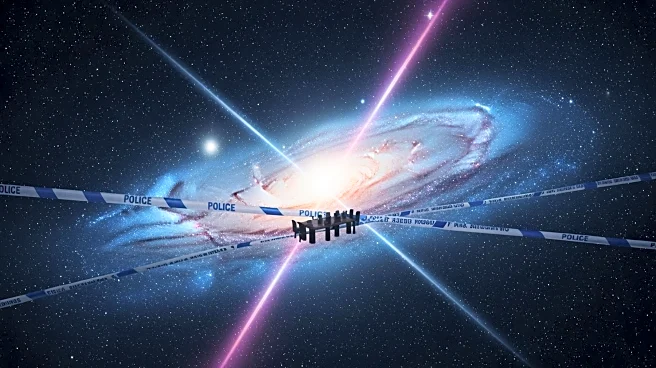What's Happening?
Recent research has revealed that the distribution of dark matter in the Milky Way is not spherical as previously thought, but rather flattened and asymmetrical. This discovery supports the theory that the gamma
ray excess observed in the Milky Way's center is due to dark matter annihilation. High-resolution simulations conducted by researchers, including those from the Leibniz Institute for Astrophysics Potsdam, have shown that dark matter is organized similarly to stars, which could explain the gamma ray excess. The study, published in Physical Review Letters, modeled the formation of Milky Way-like galaxies under conditions similar to Earth's cosmic neighborhood, providing insights into the spatial arrangement of dark matter.
Why It's Important?
The findings have significant implications for the understanding of dark matter and its role in cosmic phenomena. By confirming that dark matter annihilation could be responsible for the gamma ray excess, the study advances the search for dark matter particles that can self-annihilate. This research could lead to a deeper understanding of the mysterious nature of dark matter, which is crucial for astrophysics and cosmology. The study also challenges previous theories that attributed the gamma ray excess to millisecond pulsars, offering a new perspective on the composition and behavior of the Milky Way.
What's Next?
The study encourages further exploration into dark matter particles and their properties, particularly their ability to self-annihilate. Researchers may focus on refining simulations and observational techniques to better understand the distribution and characteristics of dark matter. The findings could also prompt new investigations into the structure of the Milky Way and other galaxies, potentially leading to breakthroughs in the field of astrophysics. Collaboration among international research institutions is likely to continue, aiming to unravel the complexities of dark matter and its impact on the universe.
Beyond the Headlines
The study highlights the importance of advanced simulations in astrophysics, demonstrating how they can provide insights into phenomena that are difficult to observe directly. The research also underscores the collaborative efforts between institutions across the globe, emphasizing the role of international cooperation in scientific discovery. Additionally, the findings may influence future space missions and the development of technology aimed at detecting dark matter particles, contributing to the broader understanding of the universe's fundamental components.











